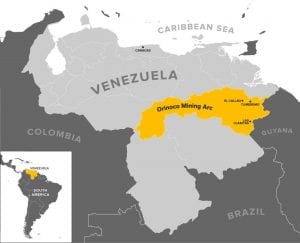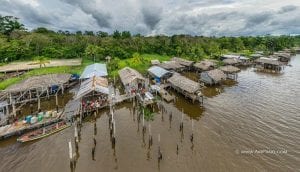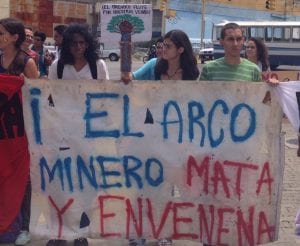Marked with Blood and Lined with Gold: Venezuela’s Return to el Orinoco Mining Arc
By: Kevelis Matthews-Alvarado
Returning to the Orinoco Mining Arc: Why now?
Original image found at: https://www.occrp.org/en/goldandchaos/gang-lords-rule-the-orinoco-mining-arc
The page Nuestra Tierra began with briefly describing some historical peaks in iron mining within this region, the Orinoco mining arc. The last peak was around the 1960s. Petroleum deposits in Venezuela were discovered in the 1920s. There were oil booms in 1950, 1970, and early 2000s. Venezuela then quickly became one of the main oil exporters in the world. Former President, Hugo Chavez had a large push in the early 2000s to gain national control over oil extraction and become a Petro-State. This intense extraction of petroleum generated billions of dollars between 1999 and 2012[i].
What is causing the resurgence of mining specifically in the Orinoco region? Venezuela economic dependency on oil extraction surfaced when the previous cash flow dried up and oil prices began to globally decline beginning in 2014. Anticipating this and as an attempt to diversify Venezuela’s economy, towards the end of his life, Chavez announced a large mining plan focusing on extraction of minerals around the Orinoco river[ii]. However, the plan never came to fruition prior to his death and this global market crash contributed to the increase in violent mining activity in the Orinoco Mining Arc.
Amongst this economic crisis and as a response, in 2016, Maduro’s administration announced a large scale economic plan to nationalize the extraction of minerals from the Orinoco Mining Arc. Many are skeptical this mining development plan can be properly implemented, due to the corruption with state military officials protecting and working with illegal mines in this region. Maduro argues that this is “an effort to start reducing illegal mining and give work to Venezuelan artisanal miners.[iii]” Additionally, the government spoke of this plan to be Venezuela’s economic saving grace, even though as of 2013 mining is statistically an insignificant part of the internal economy (representing less than 0,4 percent of activity). Moreover, two years after this announcement, there are no concrete projects working to implement the project, up to date.
Indigenous Population and Their Land
Original image found at: https://pulitzercenter.org/reporting/militarization-and-mining-dangerous-mix-venezuelan-amazon
Who does the land and its subterranean minerals belong to? We must analyze and respect the indigenous people who consistently face the direct, brute and negative consequences of mineral extraction within this region. The largest indigenous communities within the “Mining Arc” are the Warao and Ikabarú people in Bolivar and the Amazona. However, there are about 14 other officially recognized indigenous populations in this region of the country and about 198 communities[iv]. This mining arc encompasses 7 natural monuments, 7 national parks including a UNESCO World Heritage site. The indigenous people in this have a particular and significant relationship to the Orinoco river; water and nature being an important basis of culture, livelihood and existence for centuries. This is something that is constant disarray, threat and destruction with current modern surges in mining of this region. Generally, either gold or coltan are the focal minerals of these mining expeditions within this indigenous land, but also copper and diamonds are sought after too. This extraction has had detrimental health and environmental effects, and increasing mining activity will only serve to quickly and aggressively exacerbate the damage, adverse effects.
El Golpe: Adverse Effects
Coltan is a dull metallic mineral that can be refined to produce tantalum, important to construction of many electronic products like our cell phones and laptops. It is mined by hand and requires heavy deforestation for its extraction. The environmental effects this deforestation are drastic and immediate. This disrupts the wildlife and biodiversity within the region and consequently affecting the indigenous people as well, and at times forcing populations to be pushed out of where they have resided for generations and relocated to new areas. This gentrification runs deep and is highly damaging.
Mining of coltan is not the only mineral extraction more recently taking place in this ‘Mining Arc’; the illegal extraction of gold uses mercury in the amalgamation process, leading to adverse health effects and environmental damage. Mercury is a highly toxic heavy metal that is easily absorbed by human tissue. Mercury pollutes more than just the human bodies but also the wildlife and ecosystem around. Fish in Orinoco river have high levels of mercury as a direct result of this pollution. Journalist Jeanfreddy Gutierrez Torres cites 2013 RED Ara study saying, “among the most vulnerable groups, indigenous communities with a fish-based diet, as well as small children and fetuses that could suffer malformations, neurological problems, and other developmental issues[v]”. This same study shows Between 1987 and 2006, the highest doses of mercury in the world were found in mining communities in Venezuela.
Original image found at: https://imgs.mongabay.com/wp-content/uploads/sites/20/2016/01/02224711/Inmensas-lagunas-artificiales-dond-e-se-mezcla-mercurio-gasolina-y-lodo-donde-antes-hubo-un-tupido-bosque-amazo%CC%81nico-Ana-Gisela-Pe%CC%81rez.jpg
This extraction of minerals from the Orinoco Mining Arc is exploitative and violent to the environment and the indigenous people of this land. Additionally, it has caused physical violence with the directly proportional and consequently rise in organized crime and gang activity. Arguably, this growth in mining is deeply connected to violence. An increase in mining activity equates to more capital and consequent competition for resources, often resulting in violent conflict between the different actors involved. Some of the players in this situation include armed groups/organizations, the state, and miners. However, overall, this is a very nuanced and complicated topic.
To further examine different facets of this subject matter please explore the articles and sources listed below.
-
https://news.mongabay.com/2016/10/thirst-for-coltan-gold-threatens-venezuelan-forests-indigenous-lands/
-
https://venezuelanalysis.com/analysis/12417
Resistance to Plans of Expansion
Original image found at: https://venezuelanalysis.com/news/12011
Plans for expansion of already detrimental extraction has received a lot of push back and resistance from environmentalists and indigenous communities within the Orinoco region. Mining is already polluting one of the most biodiverse places in the world, and taking the life of many innocent people through adverse consequences and more direct performances of violence. Increasing extraction activity will only serve to further exploit and destroy land and people’s livelihoods. The Indigenous communities around the Orinoco, continue to reject the development of mining. There seems to be a power dynamic between mining corporations and the indigenous population[vi]. This is a relation of dominance clearly marked with the blood and lined with gold. This is a power structure of historic measures. The Orinoco Mining Arc is the title of a story, one of extraction’s exploitative nature. This is a tale that remains bloody, violent from its inception.
For more on indigenous resistance:
https://venezuelanalysis.com/analysis/11980
Works Cited:
[i] Ebus, Bram. “Digging into the Mining Arc.” Earth Journalism Network. N.p., 15 Jan. 2018. Web.18 Apr. 2018.
[ii] Mantovani, Emiliano Terano. “Crisis and Oil Depletion in Venezuela: Mega-mining and New Frontiers of Extraction.” WRM in English. N.p., 17 July 2017. Web. 18 Apr. 2018.
[iii] Ebus, Bram. “Venezuela’s Mining Arc Boom Sweeps Up Indigenous People and Cultures.” Pulitzer Center. N.p., 22 Jan. 2018. Web. 18 Apr. 2018.
[iv] Ebus, Bram. “Venezuela’s Mining Arc Boom Sweeps Up Indigenous People and Cultures.” Pulitzer Center. N.p., 22 Jan. 2018. Web. 18 Apr. 2018.
[v] Torres, JeanFreddy. “Thirst for Coltan, Gold Threatens Venezuelan Forests, Indigenous Lands.” Conservation News. N.p., 01 Nov. 2016. Web. 18 Apr. 2018.
[vi] Vitti, Minerva. “In Venezuela, Indigenous Struggles With Mining Are Far From Over.” Intercontinental Cry. GlobalVoices, 27 Oct. 2016. Web. 18 Apr. 2018.
“Gold Devils and Mining Bandits: Venezuela’s Indigenous Uprising.” InSight Crime. Venezuela Investigative Unit, 07 Dec. 2017. Web. 18 Apr. 2018.
López, Édgar, and Efecto Cocuyo. “Gang Lords Rule the Orinoco Mining Arc.” OCCRP. N.p., 19 Sept. 2017. Web. 18 Apr. 2018.
Marcello, Lucio. “Saving the Venezuelan Amazon.” Intercontinental Cry. N.p., 05 Apr. 2017. Web. 18 Apr. 2018.
Pierce, Florence. “The Coltán in Venezuela: Location and Main Characteristics.” Life Persona. N.p., 16 Oct. 2017. Web. 18 Apr. 2018.



